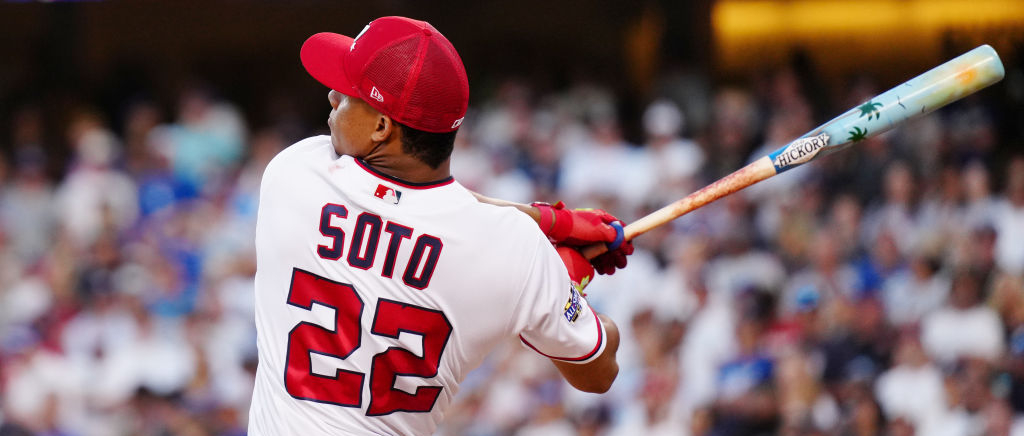Monday night’s Home Run Derby featured one of the great individual performances in Derby history from Julio Rodriguez, as he blasted 81 home runs across three rounds in a runner-up performance to Juan Soto — who mashed the longest home run of the night.
However, as impressive as the efforts of Rodriguez and Soto were, it was impossible to truly admire their work in the moment because of the Derby’s rapid-fire nature with the timed format. For years, the complaint of fans was that the Derby was too slow. The 10-out format dragged on because players took pitch after pitch, waiting for the perfect toss so they wouldn’t waste outs reaching for a bad one.
Moving on from the outs format was the right move of Major League Baseball, but they now have the opposite problem with the timed format. The event still takes three hours (but doesn’t run the risk of going any longer unless you get far too many ties that need to be broken), but you can no longer ooh and ahh at every mammoth shot as they happen, because another pitch is on its way before the last one lands in the bleachers.
The magic of the Derby isn’t simply the volume of home runs being hit, but how far baseball’s best power hitters can send it, reaching areas of ballparks once thought to be impossible to reach. Monday night there were some of these moments, like Ronald Acuña bouncing one off the canopy over the left field concourse and out of the stadium completely, but there wasn’t time to appreciate it because before that ball finished bounding out of the stadium, Acuña hit two more baseballs.
.@ronaldacunajr24 hit one out of the stadium! #HRDerby pic.twitter.com/gKVXMhBGkm
— MLB (@MLB) July 19, 2022
That’s the only way to succeed in the current format, and with $1 million on the line, the players have plenty of incentive to do everything they can to win. The problem is, that takes away from everyone’s ability to marvel at a moon shot. Acuña’s rocket to left should’ve caused pandemonium in Dodger Stadium, with his fellow players losing their minds, Ronald having the time to stand there and admire his work, and fans offering a rousing ovation. Instead, it created a quick murmur from the crowd and Acuña didn’t even know what he’d done, as he was focused on his next swings as soon as that one left the bat.
The answer to the Derby’s issue isn’t to go back to outs — which I briefly posited on Twitter last night only to get rightfully yelled at and reminded of how slow and boring that would get — but instead to go to a pitch count. Instead of each player having the chance to hit as many baseballs as possible in a certain time frame, they should get a set number. Once their pitcher has gone through the basket, that’s it.
This would solve the two biggest issues with the two formats we’ve seen in the Derby. You could be more methodical, watching each home run until it lands and letting everyone (in person and watching on TV) admire each shot without worrying about rounds dragging on forever, and you also ensure that players can’t take and take and take, because each pitch you pass on is a ball you don’t get back. If there’s concern about players being too patient and taking too long between pitches, you can set a longer clock — say 7 minutes (that’d be a 56 minute first round, which is about what it is now anyways) to get through the 40 or 50 baseballs, whatever number they land on. The biggest potential issue is the guy throwing you BP might be a disaster under the pressure of a pitch count, but let’s be honest, if you are picking someone to throw you BP and they stink, that’s on you and has always been the case during the Derby, anyway.
The frenetic pace of the current Derby is simply too hard for anyone to follow and appreciate fully what these guys are doing. Karl Ravech had a nightmarish time trying to track baseballs in L.A. on Monday night, often miscalling home runs and non-home runs because he’s trying to track one ball and immediately snap his head around to find the next before the other lands. The camera work in the current format is also impossible to do well, as they keep a constant split screen of the guy hitting on the side while trying to track each ball and snapping back and forth with every swing.
Being able to follow each home run until it lands and get full reactions from the booth, players on the field, and the guy hitting would all be a gigantic improvement on what is, to be clear, a still entertaining product. Right now, its biggest problem is that it is not as enjoyable as I think it can be.







